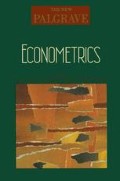Abstract
If a theory suggests that there is a linear relationship between a pair of random variables X and Y, then an obvious way to test the theory is to estimate a regression equation of form
Estimation could be by least-squares and the standard diagnostic statistics would be a t-statistic on β, the R2 value and possibly the Durbin-Watson statistic d. With such a procedure there is always the possibility of a type ii error, that is accepting the relationship as significant when, in fact, X and Y are uncorrelated. This possibility increases if the error term e is autocorrelated, as first pointed out by Yule (1926). As the autocorrelation structure of e is the same as that for Y, when the true β = 0, this problem of ‘nonsense correlations’ or ‘spurious regressions’ is most likely to occur when testing relationships between highly autocorrelated series.
Access this chapter
Tax calculation will be finalised at checkout
Purchases are for personal use only
Bibliography
Granger, C.W.J. and Newbold, P. 1974. Spurious regressions in econometrics. Journal of Econometrics 2(2), July, 111–20.
Hendry, D.F., Pagan, A. and Sargan, J.D. 1985. Dynamic specification. In Handbook of Econometrics, Vol. 2, ed. Z. Griliches and M.D. Intriligator, Amsterdam: North-Holland.
Newbold, P. and Davies, N. 1975. Error mis-specification and spurious regressions. Department of Mathematics, University of Nottingham.
Phillips, P.C.B. 1985. Understanding spurious regressions in econometrics. Working paper, Cowles Foundation, Yale University.
Yule, G.U. 1926. Why do we sometimes get nonsense correlations between time-series? Journal of the Royal Statistical Society 89, 1–64.
Editor information
Copyright information
© 1990 Palgrave Macmillan, a division of Macmillan Publishers Limited
About this chapter
Cite this chapter
Granger, C.W.J. (1990). Spurious Regression. In: Eatwell, J., Milgate, M., Newman, P. (eds) Econometrics. The New Palgrave. Palgrave Macmillan, London. https://doi.org/10.1007/978-1-349-20570-7_33
Download citation
DOI: https://doi.org/10.1007/978-1-349-20570-7_33
Publisher Name: Palgrave Macmillan, London
Print ISBN: 978-0-333-49543-8
Online ISBN: 978-1-349-20570-7
eBook Packages: Palgrave Economics & Finance CollectionEconomics and Finance (R0)

